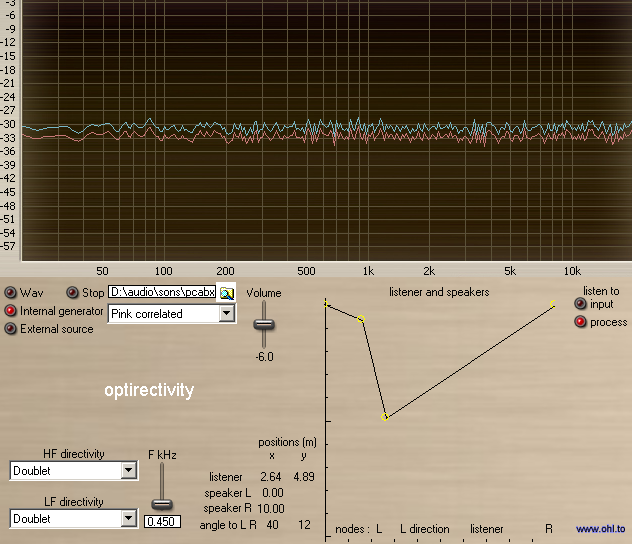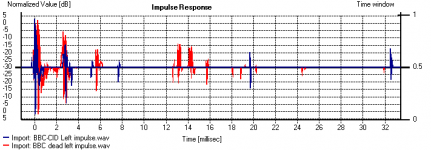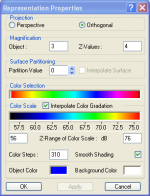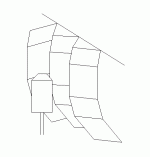Hi
Those sims are cool!
I have not seen that software, they use one called EASE at work and one they are working on we are going to offer.
Want to bog down your speedy fast computer for a couple days or more, do an aurlization in EASE of a real room like a theater or church .
It does not display like this though as is one were following a pressure impulse (what frequency is that?) like a wavetable .
How do you enter the loudspeakers directivity model, is it a common format , how detailed is it (3d spherical or polars etc)?
Best,
Tom
Those sims are cool!
I have not seen that software, they use one called EASE at work and one they are working on we are going to offer.
Want to bog down your speedy fast computer for a couple days or more, do an aurlization in EASE of a real room like a theater or church .
It does not display like this though as is one were following a pressure impulse (what frequency is that?) like a wavetable .
How do you enter the loudspeakers directivity model, is it a common format , how detailed is it (3d spherical or polars etc)?
Best,
Tom
Glad to see that my BBC control room simulations got so many comments (not). 😛
Picassa shows me nothing. (I was waiting for the issue to resolve itself 😉).
Hi Tom - yeah I'll bet a church or theater would take ages to compute. If I limit the calculations to 4 reflections, it's not too bad for this sim. Go up to 5 reflections (per ray) and it's much, much slower. Tho this room with no furniture took 90 mins on my computer, which isn't too bad. CARA does aurlization, but I think that's a premium feature I don't have. Too bad, as it would be nice for this study. I need to see if my version does it.
The speakers are JBL L120 or something (I'll check) Closest models in the CARA library to the speakers pictured in the BBC paper. I put them 1M above the floor. You can build about any speaker you want in the editor - except horns - of course!
The sims will also show frequency response across the room as well as localization and speech clarity. Since the CID approach is about reflections, that's all I showed. What is shown is a Dirac pulse, so I assume it contains all frequencies that the speaker can produce. The crossover point is specified in the speaker model.
It's good software and not too expensive.
The speakers are JBL L120 or something (I'll check) Closest models in the CARA library to the speakers pictured in the BBC paper. I put them 1M above the floor. You can build about any speaker you want in the editor - except horns - of course!
The sims will also show frequency response across the room as well as localization and speech clarity. Since the CID approach is about reflections, that's all I showed. What is shown is a Dirac pulse, so I assume it contains all frequencies that the speaker can produce. The crossover point is specified in the speaker model.
It's good software and not too expensive.
Hmmm.... don't know why. Tom saw them and they are set to public view. I can't post them here, as they are too large to attach as GIFs. Let me see what I can do about getting them in the clear.Picassa shows me nothing. (I was waiting for the issue to resolve itself 😉).
Sorry, there was a conflict at my end, it's all good.
This visualisation is excellent.
Based on some earlier playing with this, I didn't hear an improvement for anyone sitting along the sides or at the back of the room. But then again if this were used in the vertical, the reflections could sail over heads until they'd been in flight long enough to be let loose.
This visualisation is excellent.
Based on some earlier playing with this, I didn't hear an improvement for anyone sitting along the sides or at the back of the room. But then again if this were used in the vertical, the reflections could sail over heads until they'd been in flight long enough to be let loose.
Ah, thanks. So you.ve listened in a room like this? As noted earlier, it looks a lot like a bandshell. I can imagine that the effect would be best for a listener in the center, as noted in the paper.
In an amateur sense I guess... I was using the drawings I was doing earlier to play with speaker placement, and using existing furniture and some plasterboard sheets (I won't try to make any claims based on it 😉)
I believe that the horizontal and the vertical could be assessed and treated individually creating squared treatment tiers, but I wonder if it could be less ideal for a wider listening group. (I assume the horizontal treatment on its own would create a reflection free vertical cylinder).
I'd suggest a goal could be for (at least some of) the lateral reflections to be dispensed over the listeners heads (as for the ceiling bound ones) until they reach diffusion on the rear wall. This might require corners on the tiers, or upward angled side pieces and maybe just absorption for the lower parts of the front of the room?
I believe that the horizontal and the vertical could be assessed and treated individually creating squared treatment tiers, but I wonder if it could be less ideal for a wider listening group. (I assume the horizontal treatment on its own would create a reflection free vertical cylinder).
I'd suggest a goal could be for (at least some of) the lateral reflections to be dispensed over the listeners heads (as for the ceiling bound ones) until they reach diffusion on the rear wall. This might require corners on the tiers, or upward angled side pieces and maybe just absorption for the lower parts of the front of the room?
I'm not quite picturing what you have in mind. I did find that if the walls (only) were stepped, there were more reflections inside the 20ms window. Adding the horizontal pieces cleaned up the room further. They would be a lot hard to add to a room, I think.
Below is the impulse response of both rooms. CID is in Blue, Dead in Red. Despite all the absorption in the Dead room, the CID room appears to have a cleaner impulse for the fist 30ms or so. Only the Left speaker is shown, for clarity.
Below is the impulse response of both rooms. CID is in Blue, Dead in Red. Despite all the absorption in the Dead room, the CID room appears to have a cleaner impulse for the fist 30ms or so. Only the Left speaker is shown, for clarity.
Attachments
Glad to see that my BBC control room simulations got so many comments (not). 😛
https://production.diyaudio.com/community/index.php?posts/3019353/
I guess computer OSes are a more interesting topic. No matter, it taught me a lot about rooms and is an approach that I hope to use sometime soon. I've been looking for good diffraction or diffusion techniques for the front wall, this just may be the ticket. Doing just the vertical section helps, but adding the horizontal soffits really seals the deal.
Here's a comment or, rather a question. What doe the yellow, blue and green areas represent?
Good question, sorry I did not explain it! The colors represent the SPL at that place in the room (at 1M high, in this case). Red is 76dB, then as the levels drop they go thru orange, yellow, green, cyan, blue then to black at 56dB and below. Color = SPL.
Attachments
Good question, sorry I did not explain it! The colors represent the SPL at that place in the room (at 1M high, in this case). Red is 76dB, then as the levels drop they go thru orange, yellow, green, cyan, blue then to black at 56dB and below. Color = SPL.
I watched the simulation video and saw the colored bands propagate from left to right. Can I assume this is the wavefront of a single pulse rather than some continuous sine wave?
Glad to see that my BBC control room simulations got so many comments (not). 😛
https://production.diyaudio.com/community/index.php?posts/3019353/
I have trouble understanding what you have shown and how it shows something of interest. I saw your plot of the Log impulse response and this was far more interesting to me. But the color movie was not very descriptive AFAI could tell.
FWIW, I see it as giving feedback to the room design process.
HTH.Pano said:I'm not quite picturing what you have in mind.
Attachments
It shows the reflections in the room, their direction, duration and SPL. That's very informative to me. I agree, the impulse also tells a good story.But the color movie was not very descriptive AFAI could tell.
In quest of the ideal directivity 😕, I did an auralisation software to listen to a pair of speakers with various directivities and changing listener place

Level and time difference of each speaker is calculated in real time when you move listener position or rotate speakers.
It is impressive of much the stereo image is degraded in case of omni speakers when you move to the nearest speaker. Interesting is the possibility to toe-in doublet or cardioid speakers but I haven't found yet an optimal angle so that a central sound image stays really fixed in front.
For those you wanna try, this free soft is here : http://www.ohl.to/audio/downloads/optirectivity.zip, it's a vst plugin or standalone, only for windows. It's very new so it surely has some bugs 😉
Hope it is easy enough to use without manual : I hate to write manuals😀

Level and time difference of each speaker is calculated in real time when you move listener position or rotate speakers.
It is impressive of much the stereo image is degraded in case of omni speakers when you move to the nearest speaker. Interesting is the possibility to toe-in doublet or cardioid speakers but I haven't found yet an optimal angle so that a central sound image stays really fixed in front.
For those you wanna try, this free soft is here : http://www.ohl.to/audio/downloads/optirectivity.zip, it's a vst plugin or standalone, only for windows. It's very new so it surely has some bugs 😉
Hope it is easy enough to use without manual : I hate to write manuals😀
You can never get good image using auralization software. If you use earphone, they need to be carefully designed, none of which I have found to be satisfactory; if you use real speakers, then you have the room effects already.
Does this mean CID is better than an anechoic room?I'm not quite picturing what you have in mind. I did find that if the walls (only) were stepped, there were more reflections inside the 20ms window. Adding the horizontal pieces cleaned up the room further. They would be a lot hard to add to a room, I think.
Below is the impulse response of both rooms. CID is in Blue, Dead in Red. Despite all the absorption in the Dead room, the CID room appears to have a cleaner impulse for the fist 30ms or so. Only the Left speaker is shown, for clarity.
- Status
- Not open for further replies.
- Home
- Loudspeakers
- Multi-Way
- What is the ideal directivity pattern for stereo speakers?



